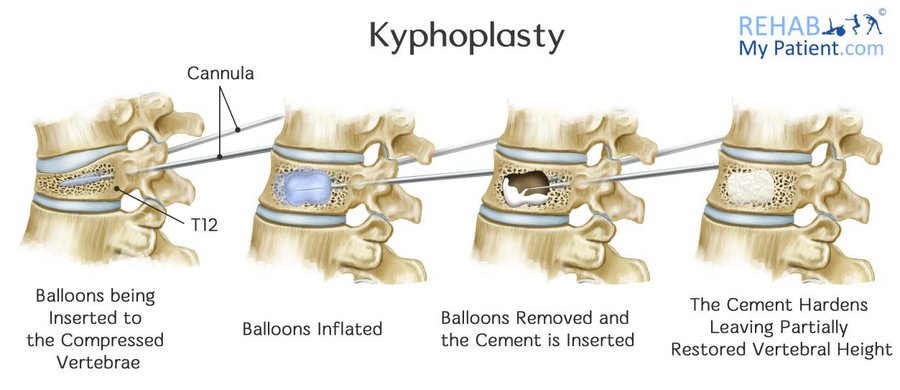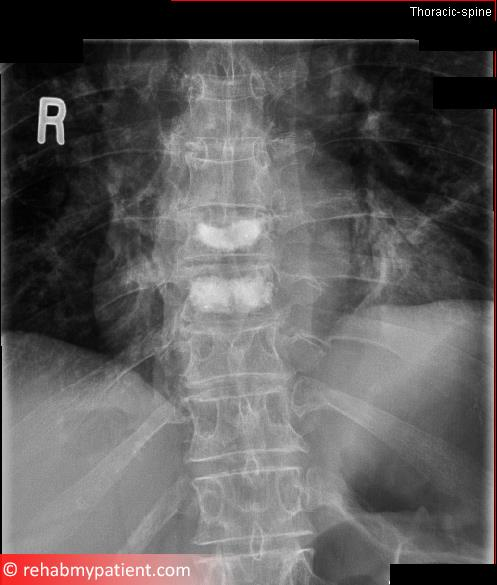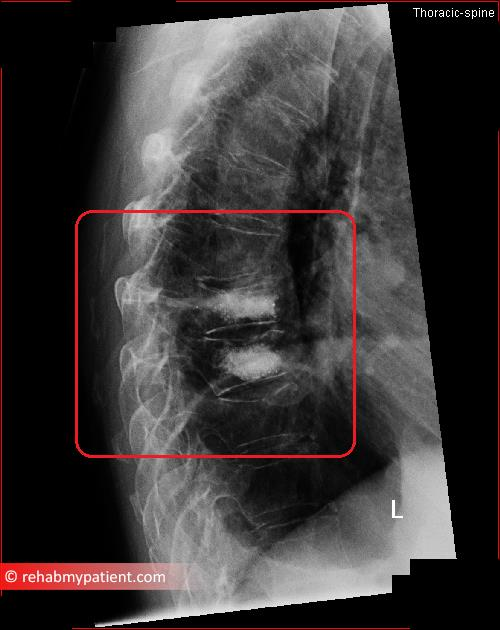
Kyphoplasty is a surgical procedure that is used to treat vertebral compression (crush) fracture.
Vertebral compression fractures are fractures that occur when a vertebra in the spine collapses due to trauma. The fracture can also be caused by cancer, osteoporosis and any number of other conditions. Symptoms most often are simply pain in the back. The pain is central and spreads laterally both sides in the spine. The patient will usually be aware there has been a trauma (sometimes a small
trauma) such as a fall.
By far the biggest contribution to wedge fractures is osteoporosis. If the spine is osteoporotic, there is thinning of the bone and even small traumas or falls might cause a collapse. Rarely, the collapse can occur without explanation, with the sufferer having no recollection of a fall or trauma.
In most cases, trauma has occurred and the majority of traumas involve a fall where person slips and lands on their backside. The fracture typically occurs at the level between the upper and lower back, known as the thoraco-lumbar junction. Common vertebrae affected are T11, T12, and L1.
Kyphoplasty is sometimes known as balloon kyphoplasty. The patient is given a general anaesthetic. A small incision about the width of your finger is made into the spine both sides. A tube is placed and the procedure is carried out under X-ray to ensure the tube is placed accurately. Inside the tube a small balloon is inserted into the collapsed vertebra. The balloon is inflated, and then removed leaving a cavity. A cement is placed through the tube and guided into the cavity within the collapsed vertebra. Within minutes, the cement has hardened to stabilise the vertebra. The tube is removed and a stitch is used to close the incision site. Patients are sent home the same day.
Vertebral Crush / Compression Fracture Anatomy
Bones in the spine are known as vertebrae (plural). They are stacked one on top of each other and are joined by facet joints and discs that sit in-between each vertebra. Spinal nerves are at each level and exit from the spinal cord through holes between the vertebrae known as foramen.
When the vertebra crushes or collapses, it tends to collapse at the front. This is why compression fractures are sometimes known as "anterior wedge fractures". As the bone at the front of the vertebra collapses, it forms a wedge shape. Depending on the severity of the fracture will depend upon the level of wedging that occurs. Also if there is underlying weakness in the bone, for example in osteoporosis, then the wedging is likely to be more pronounced.

In a younger person without osteoporosis, the trauma would need to be significant to have enough force to fracture the vertebra, such as a fall from a height, or a high impact injury such as skiing or horse-riding.
X-Rays showing the cement following successful kyphoplasty operation for two fractured vertebrae
How to Diagnose a Compression Fracture to the Spine
Diagnosis is not easy and it is possible for these to be missed. In some cases with just a history it is possible to diagnose the fracture, for example if a known osteoporotic person has had a fall. However, in many cases, the pain may present as other issues in the spine. During a physical examination there are some tests which can be done to help diagnose a vertebral crush fracture, however it is known that these tests are not particularly reliable and can create false-positives. The ideal way to see a compression fracture is with an X-Ray or MRI scan. If the fracture is severe, then a CT scan may also be performed.
Problems Following a Crush Fracture to the Spine
In the early days, there will be pain around the injury site. However, once this pain and restriction settles, patients often report pain lower down their spine at the base of the spine. This is because the wedging of the vertebra causes a forward shift of weight-bearing which places more strain in the lower back. Sometimes this can become very chronic and patients may have to deal or manage with a certain level of pain or discomfort at the base of the spine.


X-Rays showing the cement following successful kyphoplasty operation for two fractured vertebrae
How to Rehabilitate Following Kyphoplasty
- Anti-Inflammatory Medication
An anti-inflammatory medication will be prescribed to help in terms of pain and inflammation following surgery, for at least two weeks, and maybe longer if required. Do not come off the medication too soon as there will be inflammation from the surgery. - Avoid All Forward Bending
The fracture has collapsed the front of your vertebra, so bending forwards will place stress on the front of your vertebra. Although the vertebra is now stabilised and cemented, reducing weight bearing through the front is recommended for 6-12 weeks following kyphoplasty. - Modification of Activities
Activities that cause pain in the back should be avoided. Modifying your activities according to what your individual pain level and tolerance is can help to avoid additional injuries from occurring. Do not try and lift anything heavy, or anything that is going to cause too much strain on the fractured site. - Bracing
Applying a brace to the affected area can help to prevent additional movement and pulling of the injured site. Braces can help to keep the spine securely in place to promote the healing process. Since it restricts movement in the spine and conforms tightly to your body, it will prevent you from bending over. The spine is held in a neutral position, which alleviates pressure on the fractured vertebrae and allows it to heal properly. Bracing is not a necessity following kyphoplasty but some patients may find it useful. Short term use is recommended otherwise the back and core muscles can become reliant on the brace. - Physio and Rehab
Rehabilitation from a therapist is very important following kyphoplasty. This will help reduce the forward bending of the spine, reduce inflammation, reduce muscle spasm and help significantly with the pain. Never miss out on the rehab this is a very important part of your recovery.
Sign Up
Sign up for your free trial now!
Get started with Rehab My Patient today and revolutionize your exercise prescription process for effective rehabilitation.
Start Your 14-Day Free Trial